“And the Children Shall Lead”
Written by Edward J. Lasko
Directed by Marvin Chomsky
Season 3, Episode 5
Production episode 60043-60
Original air date: October 11, 1968
Stardate: 5029.5
Captain’s log. Kirk, Spock, and McCoy beam down to Triacus, a scientific outpost, responding to a distress call. They materialize to find a whole lot of dead bodies. There’s only one survivor: Professor Starnes, but he dies after a minute, and he doesn’t recognize Kirk before he croaks.
One of the corpses has a bottle of poison in her mouth, and Starnes’s last log entry on his tricorder indicates that they have to all kill themselves because of the enemy within. (Gee, that would make a great title…)
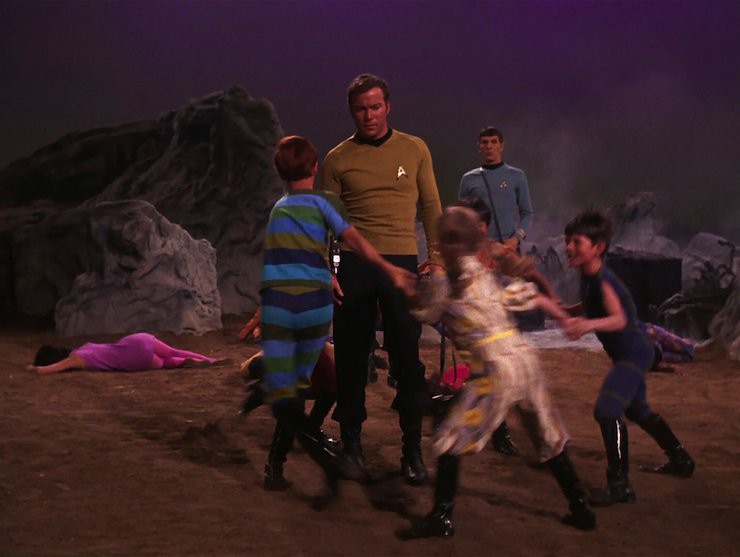
A bunch of kids run out and start playing, completely oblivious to the fact that their parents are all dead around them. A security team beams down and forms a burial detail. But the kids are still all completely unconcerned. McCoy feels this is their extreme reaction to the horror of their parents killing themselves, a kind of traumatic amnesia to not face the reality of their situation.
Kirk interrupts another game to have them beam up to the ship to be examined by McCoy. Spock hypothesizes that an outside force may have induced the mass suicide and that same force may have left the children safe for whatever reason, whether due to a quirk of biology or an intelligence.
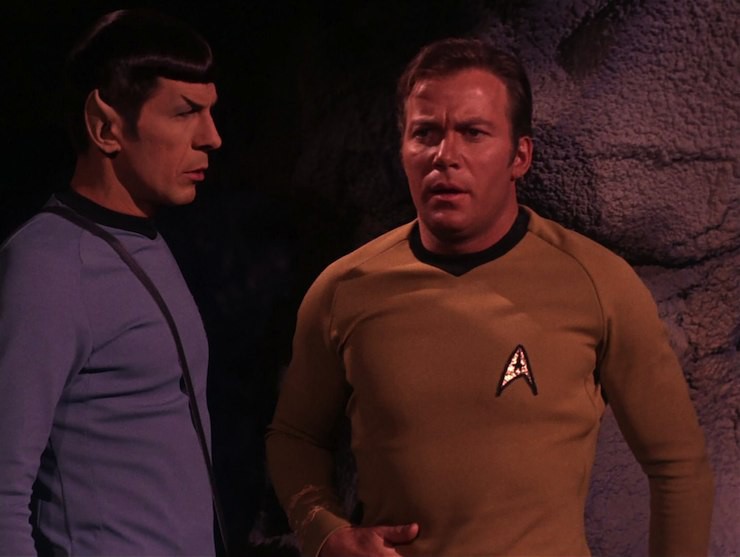
Spock picks up a reading from a nearby cave. He and Kirk investigate (leaving the two security guards to stand around with their thumbs up their asses, I guess), and Kirk gets a massive wave of anxiety just from being in the cave.
Chapel takes the children to the arboretum and feeds them ice cream. McCoy reports no ill health, nothing physically or psychologically wrong with them, except for the part where they don’t care that their parents are dead.
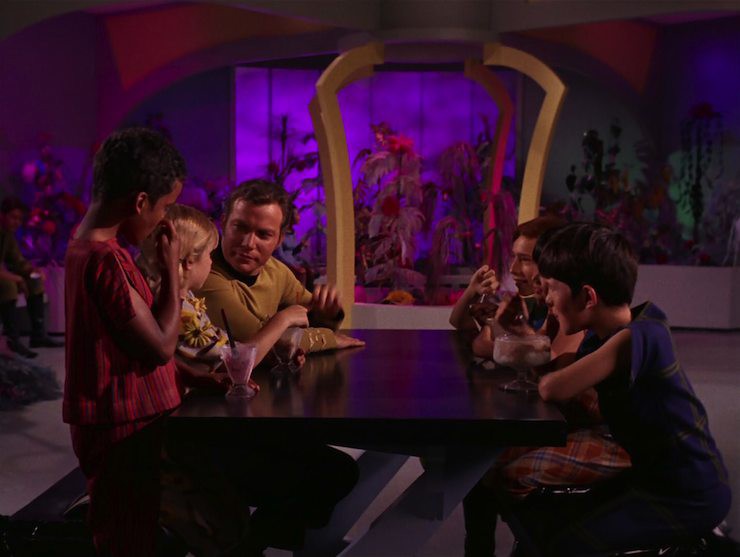
Kirk sits to talk to them, and the kids make it clear that they’re thrilled to be off Triacus. When Kirk tries to discuss their parents and how much they love them, they start playing a game where they act like bees, running around crying “Busy!” Kirk denies them more ice cream, as it will spoil their dinner. Starnes’s son, Tommy, grumbles that grown-ups all say that.
Chapel takes the kids to their quarters, but Kirk holds Tommy back and asks him about what happened to his father. Tommy is evasive, saying only that his father was upset like he always was and that he was happy down on that dirty planet.
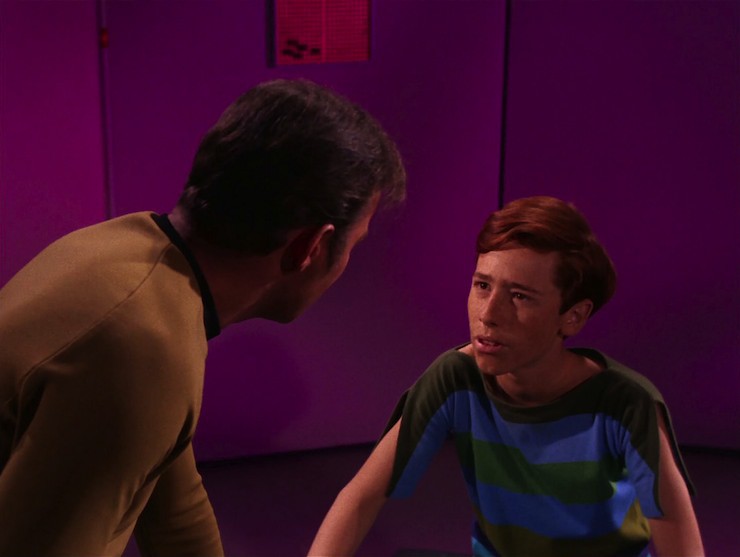
In their quarters—Kirk puts them under guard—they get in a circle and utter a chant that summons a big green glowy fat guy who tells them that they’ve done well to get on the Enterprise. The next step is to get to a bigger Federation outpost to gather more “friends,” and more people for the kids to play with. The kids start pounding on the table while the glowy fat guy tells them that the next step is to control the crew.
Spock pulls Starnes’s log entries, where he describes a growing feeling of anxiety, similar to that which Kirk experienced in the cave. Tommy comes to the bridge (accompanied by a security guard), and he proves able to make the log entry go blooey. After asking Kirk to take the ship to Marcos XII, and being denied, he asks Kirk if he can stay on the bridge. Kirk agrees, then goes off with Spock to meet up with McCoy in his quarters.
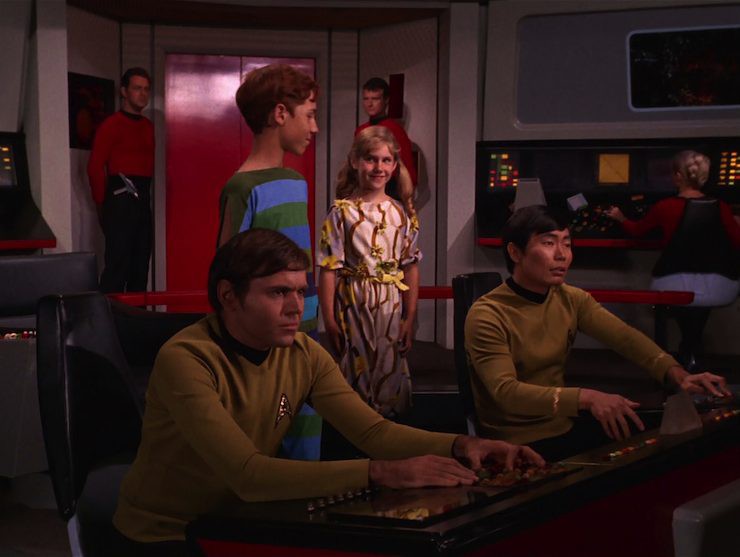
Once Kirk and Spock are gone, Tommy influences Sulu to take the ship out of orbit and pilot it toward Marcos XII. The kids are powerful enough to fool everyone into thinking that they’re still in orbit of Triacus.
Kirk, Spock, and McCoy view Starnes’s last entry, in which he was panicked and afraid of an enemy from within that would destroy them. Spock reports that legend has it that Triacus was the home of marauders, and legend said that the great evil of the marauders was awaiting a catalyst to return.
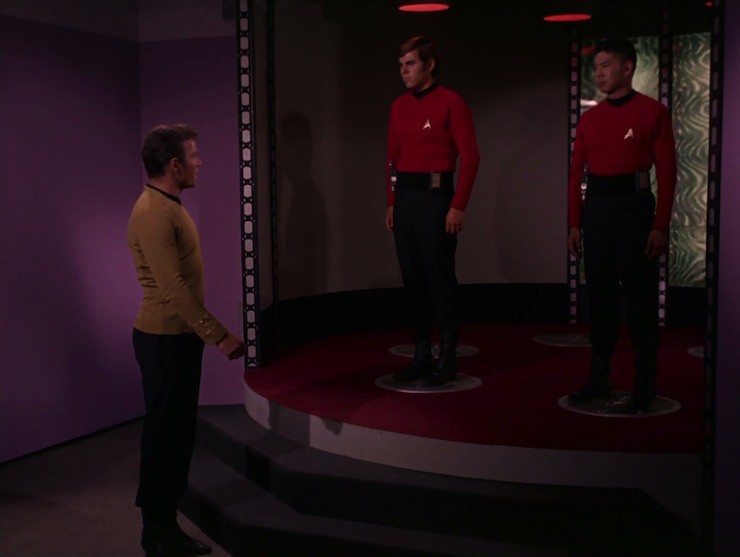
Kirk orders a relief security detail beamed down to Triacus, and intends to question the two who’ve been on-planet. But after beaming them down, they’re unable to retrieve the party on the planet—and Spock realizes that they’re not in orbit of Triacus, which means the two guards were just beamed into space.
The kids are all on the bridge when Kirk arrives, wondering why Sulu is insisting that they’re in orbit when they’re not. The kids then summon their “friendly angel,” and the glowy green fat guy instructs them to return to their posts and to unleash the crew’s “beasts” if they resist.
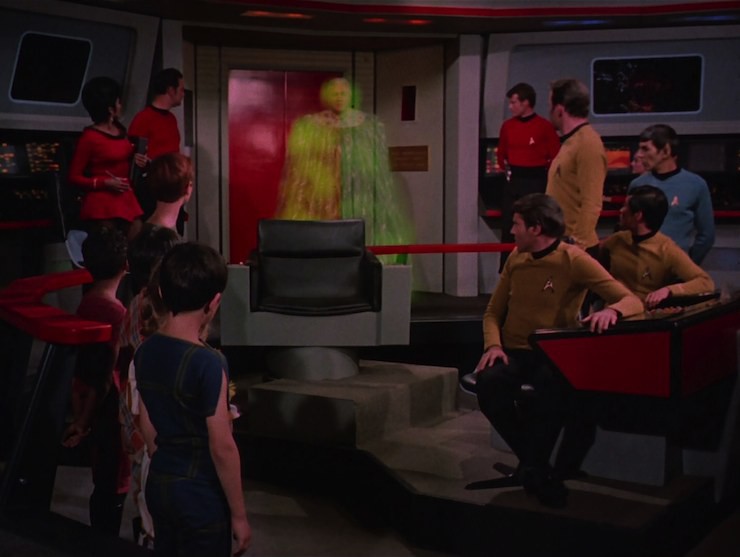
The crew just—well, stand there while this happens. Kirk orders Sulu to set course for Starbase 4 and Uhura to contact the starbase, but Sulu can only see a bunch of swords flying at the ship, while Uhura sees herself as a diseased old woman about to die a horrible death. Spock then disobeys Kirk’s orders, seeing no need to alert Starfleet when everything is under control. Then Tommy causes all of Kirk’s words to be gibberish, and when Kirk realizes that Tommy is causing it, Kirk is overcome by an anxiety attack.
Spock winces and puts his fingers to his head, at which point he announces that they have to leave the bridge. In the turbolift, Kirk’s panic attack grows worse, but he gets himself under control after shouting and gripping the walls a lot.
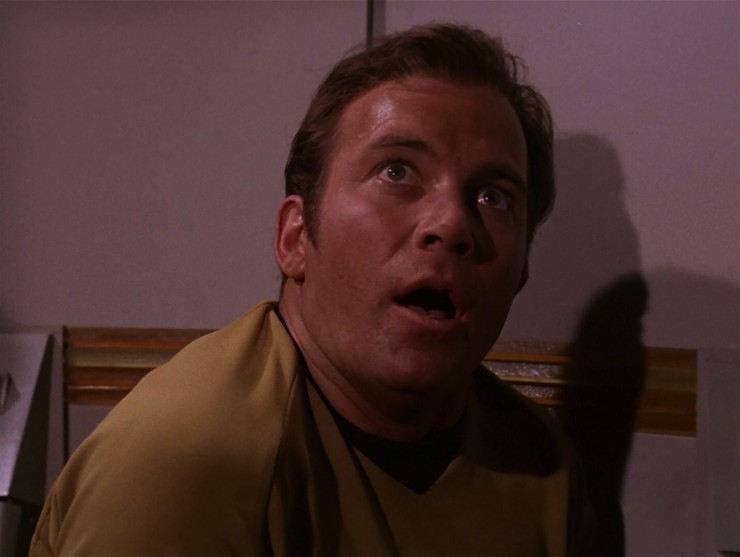
They go to auxiliary control, but Scotty is under the kids’ power now, and he refuses to override the bridge controls. Fisticuffs ensue for a bit, but then Kirk and Spock leave, only to have Chekov and a security detail try to arrest them—supposedly under Starfleet Command’s orders, but truly under Tommy’s. Chekov pulls a phaser on them. Fisticuffs ensue again, but this time Kirk and Spock are victorious and put the trio in detention.
Kirk goes to the bridge, where Tommy insists he’s not afraid of Kirk. But Kirk thinks that their friendly angel is the one who’s afraid. The kids refuse to summon him, so Spock just plays the recording of the kids doing their chant, and sure enough, the glowy green fat guy appears. Kirk announces that he has overcome his “beast,” and the crew will fight him, too. The glowy green fat guy scoffs at the puny humans with their morality and gentleness.
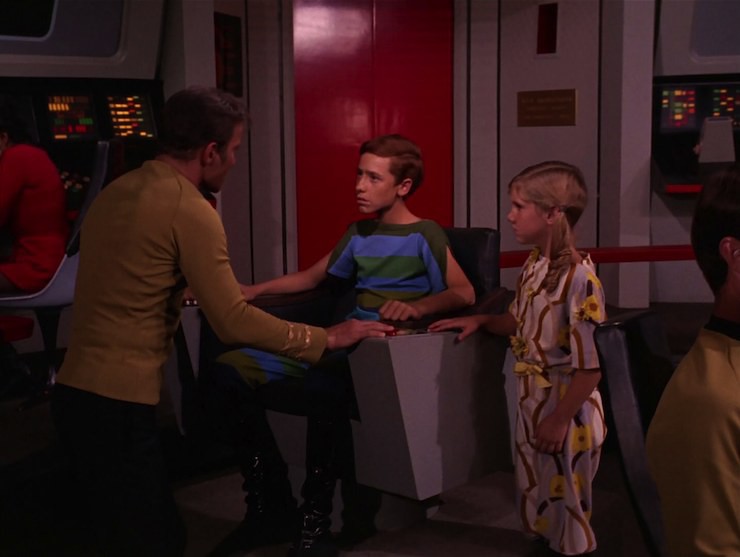
So Kirk takes another tack, showing the recordings that Starnes made of the kids playing with their parents and having fun. And then he cuts to their dead bodies. The glowy green fat guy insists that they had to be eliminated because they wouldn’t get him off the planet.
But for the first time, the kids realize what has happened, and they start to cry and grieve at last. Without the kids to support him, he starts growing pustules and boils and gets all icky and stuff.

And then he disappears. Sulu no longer sees the swords, Uhura no longer sees her dying self, and the kids have a cathartic cry. McCoy takes the kids to sickbay so they can be properly treated and Kirk orders Sulu to take the ship to Starbase 4, having totally forgotten that he left two security guards on Triacus.
Fascinating. Spock is able to overcome the “beast” inside him, presumably with his telepathy. Because he’s just that awesome.
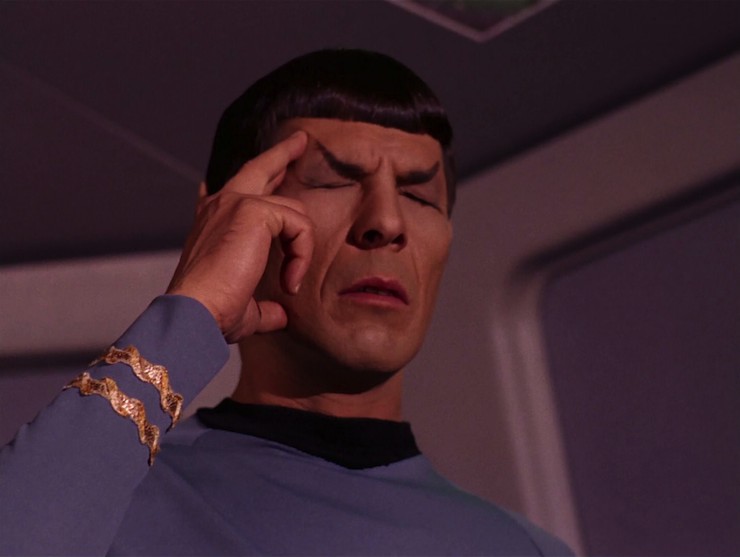
I’m a doctor not an escalator. McCoy’s concern throughout is for the well being of the children, constantly expressing concern that they be able to work through the grieving process in a way that isn’t psychologically damaging. Which speaks very well of the good doctor.
Ahead warp one, aye. Sulu is made to be deathly afraid of animated swords flying in circular formation at the ship. Sure.
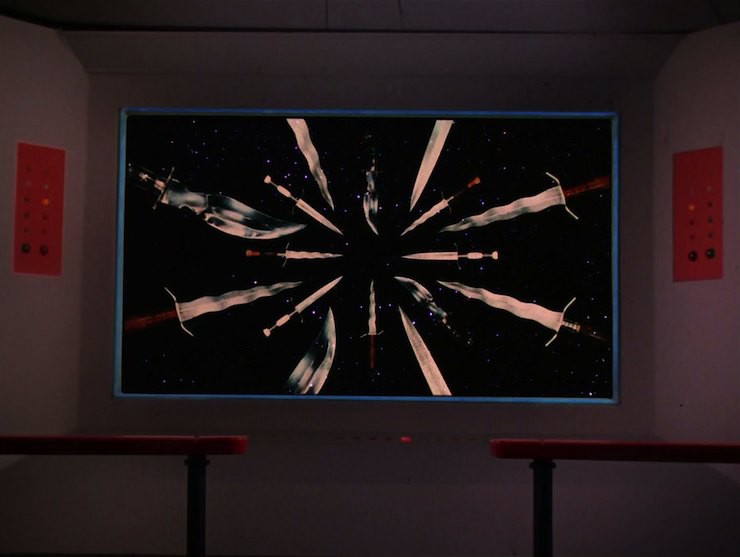
Hailing frequencies open. Uhura breaks down in tears because she some day will be old. Sure.
It’s a Russian invention. Chekov gets to pull a phaser on his captain and get beat up for the privilege.
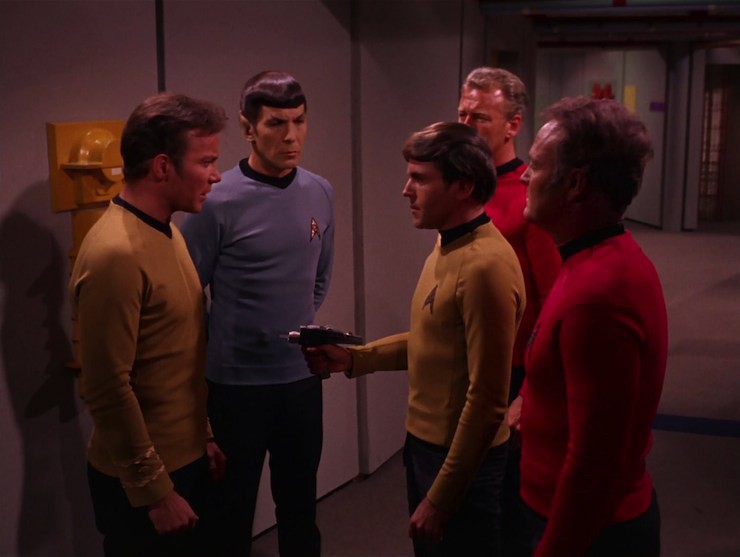
I cannot change the laws of physics! Scotty immediately resorts to fisticuffs when his engineers refuse to change course—remember, this is before he’s under the kids’ influence—and then does the same with Kirk while he is under the kids’ influence.
Go put on a red shirt. Kirk orders two security guards beamed down to the planet, but they’re in interstellar space, so they’re beamed nowhere and killed. Kirk barely even notices, more grumpy about the fact that his ship isn’t where it should be than the fact that two of his crew are dead. And he seems to have totally forgotten that there are two guys on Triacus, whom he doesn’t even go back for or make any attempt to contact in the end.
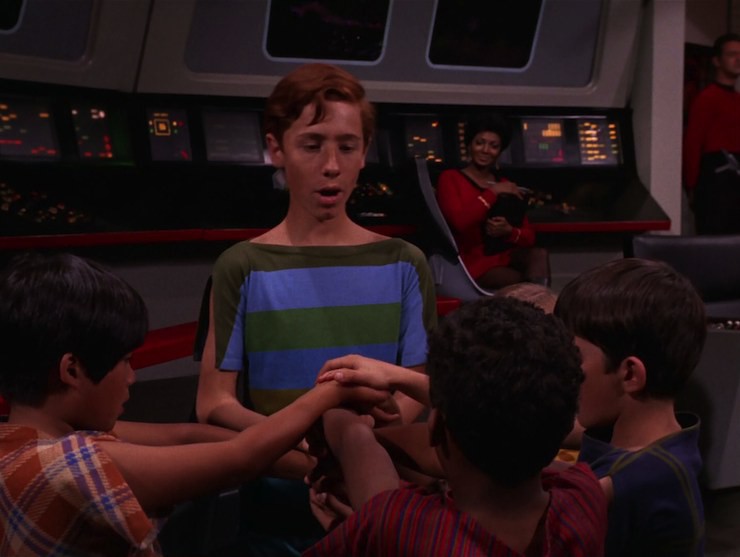
Channel open. “Hail, hail, fire and snow.
“Call the angel, we will go.
“Far away, for to see.
“Friendly angel come to me.”
It’s been stuck in my head since I watched the thing, so now it’s stuck in yours. I’ve never believed in the virtue of suffering in solitude. You’re welcome.
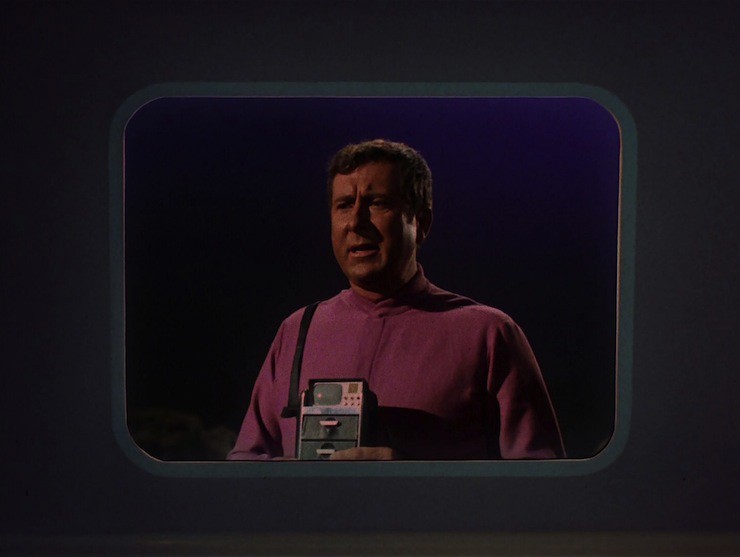
Welcome aboard. Craig Hundley, who last appeared as Kirk’s nephew Peter in “Operation—Annihilate!” is back, and actually doesn’t have his lines cut as Tommy. James Wellman plays Starnes, while the other kids are played by Pamelyn Ferdin, Caesar Belli, Mark Robert Brown, and Brian Tochi. Tochi will later return as a grownup on TNG as Ensign Lin in “Night Terrors.”
Plus we’ve got all the major recurring regulars in George Takei, James Doohan, Nichelle Nichols, Walter Koenig, and Majel Barrett.
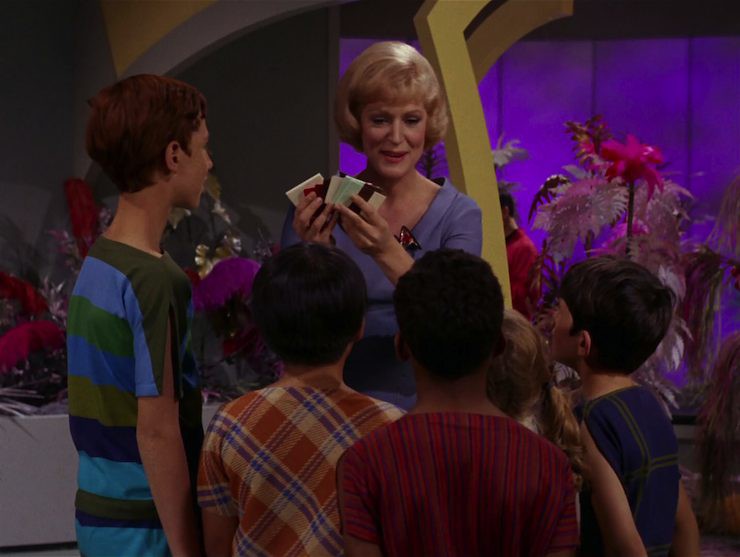
But the “big” guest is total non-actor Melvin Belli as the glowy green fat guy. Made available by the casting of his child-actor son Caesar, Belli was a very famous (some might say infamous) attorney. Among his clients were Jack Ruby, the gangster who shot Lee Harvey Oswald, as well as actors Tony Curtis, Errol Flynn, Zsa Zsa Gabor, Lana Turner, and Mae West, musicians Chuck Berry and the Rolling Stones, boxer Muhammad Ali, evangelists Jim and Tammy Faye Bakker, etc.
Trivial matters: This episode introduces the United Federation of Planets flag.
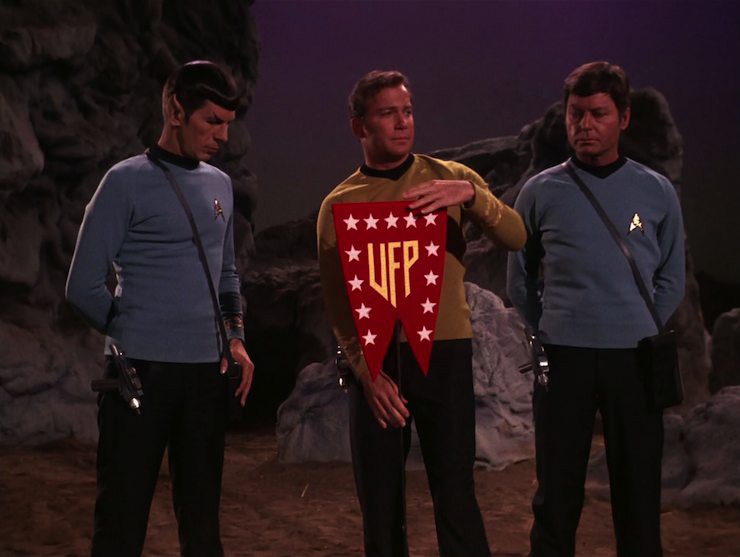
Brian Tochi is the fourth child actor to appear in the original series who would later be cast as an adult on a spinoff or movie. The others include Phil and Iona Morris, who appeared in “Miri” and were later cast in Star Trek III: The Search for Spock (Phil), Deep Space Nine (Phil, twice), and Voyager (both); and Clint Howard, who appeared in “The Corbomite Maneuver,” and was later seen on both DS9 and Enterprise.
The glowy green fat guy is referred to as “Gorgan” by Kirk late in the episode, but it’s unclear how he came to learn that name, as it’s never mentioned elsewhere.
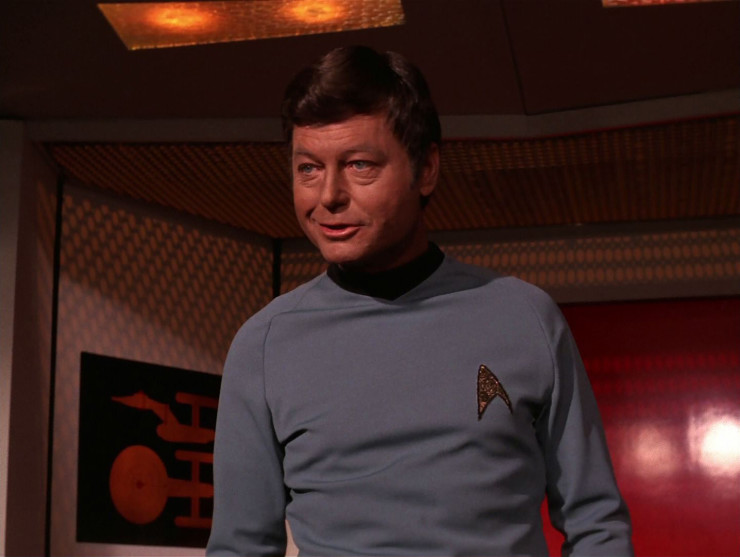
Gorgan was established by Greg Cox in The Q-Continuum trilogy as part of a band of powerful beings who spread chaos throughout the galaxy, alongside Q from “Encounter at Farpoint” and onward, “God” from Star Trek V: The Final Frontier, and the swirly thing from “The Day of the Dove.”
Fred Freiberger apparently cast Melvin Belli as a ratings stunt, one he later regretted.
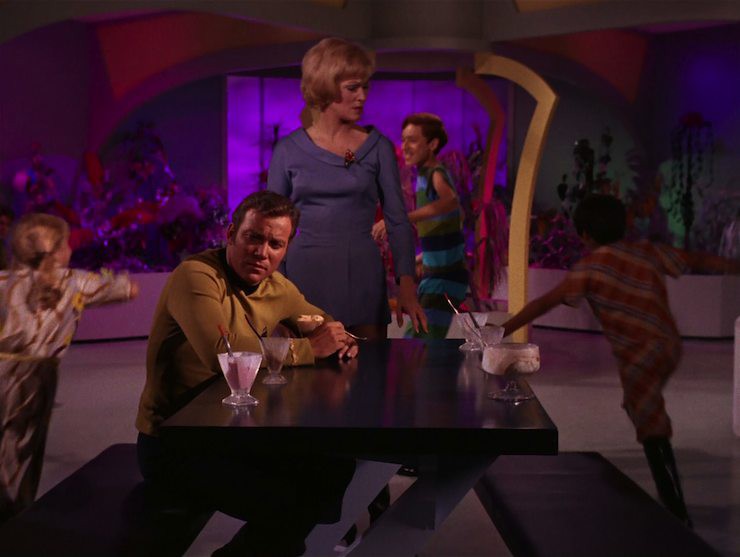
To boldly go. “Parents like stupid things.” I have a lot of trouble with this one for reasons that aren’t entirely the episode’s fault.
Well, they’re partly the episode’s fault…
As I’ve mentioned elsewhere in this rewatch, I grew up watching Star Trek on Channel 11, WPIX in New York City throughout the 1970s. But there were two episodes that I just could not watch for years, because as a small, impressionable child they gave me nightmares. One was “The Man Trap,” because of the salt vampire, and the other was this one, because of Melvin Belli as the glowy green fat guy. I got over it with the former, but because of the visceral oogies I got from the glowy green fat guy, I avoided watching “And the Children Shall Lead” as much as possible. In fact, prior to this rewatch, the only time I watched the episode since childhood was at the Shore Leave convention, where Peter David, Michael Jan Friedman, and Robert Greenberger played and commented on it for Mystery Trekkie Theatre 3000, an annual tradition at that convention.
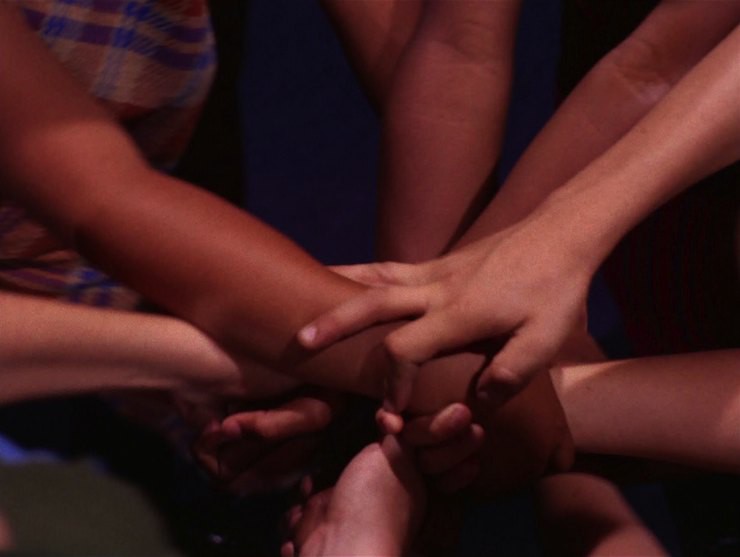
Having now pretty much outgrown my primal fear of glowy green fat guys, I can watch the episode more objectively—and it still really sucks. I’ve missed nothing not watching it all these years.
Oh, it has its moments. The child actors are actually all quite good, particularly the always excellent Pamelyn Ferdin and the intense Mark Robert Brown—the shots of Brown through the grating in auxiliary control doing the punch-the-air thing while Scotty and the engineers go all pugilistic are very effective.
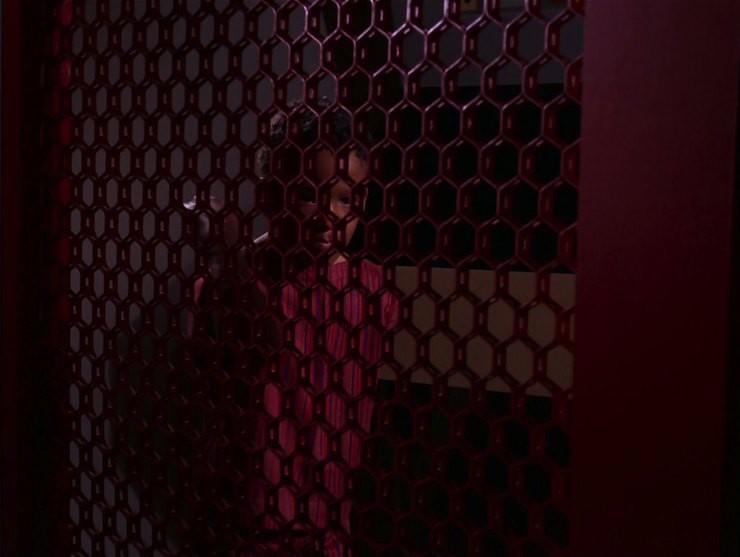
But overall, it’s a disaster, taking all the worst elements from “Charlie X” and “Miri” without any of the good bits. The pacing could generously be described as “languid,” made worse by the characters just standing around while the ship goes to pieces around them. The fist-pumping gesture that is (over)used by the kids to signify their taking control loses visual effectiveness after about the third time. Kirk and Spock overcome the mental control basically by the power of being in the opening credits while the rest of the crew get to be manipulated with great ease and no ability to fight back. The two security guards who are beamed into space are disregarded instantly, and the ones they were being sent to replace are probably still screaming into their communicators on Triacus wondering what the hell happened to their ride. And as an actor, Melvin Belli makes a great attorney.
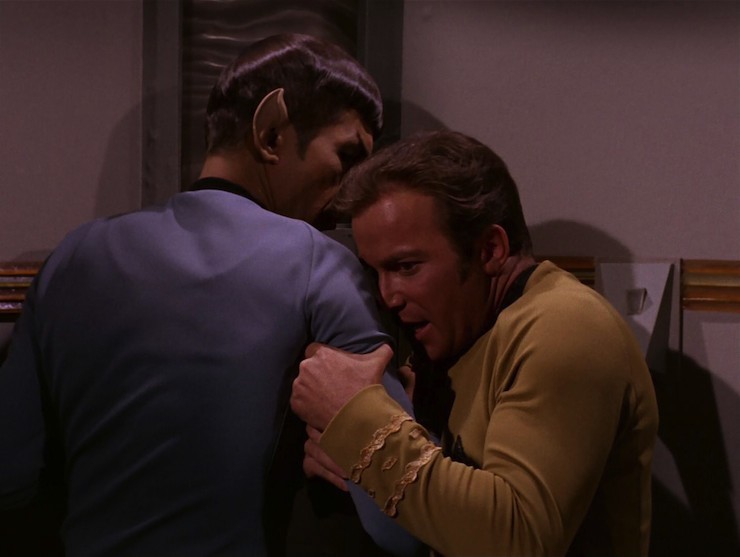
Warp factor rating: 2
Next week: “Spock’s Brain”
Keith R.A. DeCandido urges folks to support the crowdfunding campaign for Altered States of the Union, an alternate history anthology being put together by Crazy 8 Press and ComicMix, featuring a story by your humble rewatcher about the Conch Republic of the Florida Keys, as well as stories by Trek scribes David Gerrold and Michael Jan Friedman, as well as Debra Doyle & James D. Macdonald, Brendan DuBois, Malon Edwards, G.D. Falksen, Alisa Kwitney, Gordon Linzner, Sarah McGill, Mackenzie Reide, Ian Randal Strock, Ramon Terrell, and more besides! The book will launch at Shore Leave 38 in July.










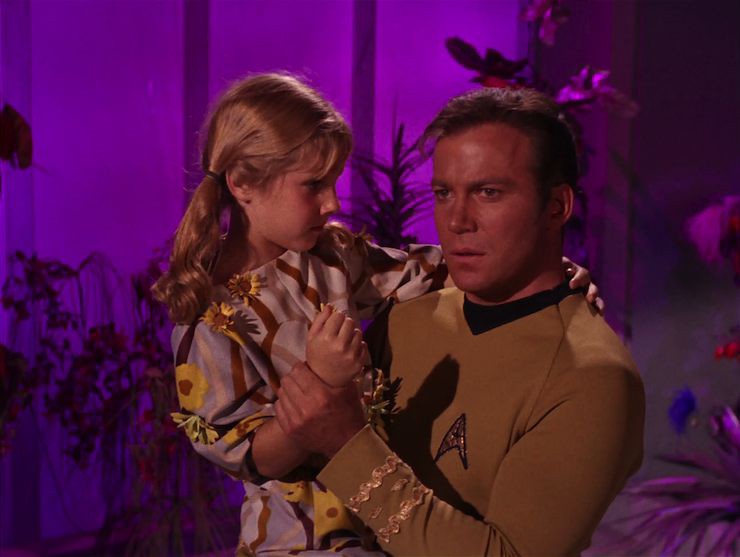
A 2 is generous for this episode when Enterprise Incident only gets a 1. But I do have a bit of soft spot for this episode, in part, because it marks the only time I can recall where Trek openly and explicitly acknowledges the existence of evil, which is so rare in the secular, humanist vision that is typical of Trek. Although I am not particularly religious, I do think evil is a thing, having sadly seen too much of it in history and on the news….
The only bright spot in this episode for me is…well, no, there isn’t one. So much wrong here. And when I got to the end and saw that “Spock’s Brain” is next week, I was reminded why the third season is panned more than the first two.
As you note, the child actors are decent, but that’s about this episode’s only saving grace.
I do wonder, though, how long it took to wipe the muck off Pamelyn’s face after she “cried.”
Craig Hundley would later return to the Trek movies as Craig Huxley. He’s now a composer, musician, and music producer.
http://www.imdb.com/name/nm0402137/bio
Among other things, he created an instrument called the “Blaster Beam” which was used for some of V’Ger’s music, and composed the Genesis Project music in Wrath of Khan.
I consider this the worst episode of Star Trek, ever. Spock’s Brain is often mentioned for that distinction, but at least it’s entertaining. ATCSL is just…painful.
This is the first time in the third season that I agree 100% with the rating.
Some additional things I like about the episode:
The ice cream scene. When was the last time we got such a lovely little Chapel scene? “That was your unpleasant surprise. Now, what would you like for your pleasant surprise?” – There’s a touch of Lwxana Troi there, in a good way.
It’s the only episode that shows us a glimpse of 23rd century family life. It’s nice to see that it’s perfectly possible to have a family on a scientific outpost, even if it isn’t possible on a starship. And those children seem to come from all over the world – that’s nice too. Some of the parents even have names that don’t sound British (Janowski, Tsing Tao).
The fact that Chekov leads a security detail is fun, considering that he becomes a security officer later in life.
Btw, I don’t think that Uhura is afraid of getting old – she’s afraid of dying of some terrible illness (“A long death. Disease and pain”). As a secret fear, I find that more understandable than the others.
I must confess that I shared our humble reviewer’s fear of the “Gorgan” (is that name for the entity in the script? Kirk seems to pull it from thin air) as an impressionable ten year-old. Now, when I see him in his vinyl shower curtain, I struggle to suppress a laugh. The same could be said for this entire episode. From Sulu’s vanilla bad trip to a Scotty that launched a thousand impressions, to the priceless expression on the face of the redshirt on the bridge to the masterclass in over-the-top Shatnerian acting in the turbolift, this episode is comedy gold. The insulting notion that Uhura’s worst fear is aging is the sexist cherry on top. Writer Edward J. Lakso’s filmography has Mission: Impossible, Mannix, The Rockford Files, and others to its credit but it seems that he met his Waterloo on Triacus. A 1/10 at very best.
What’s that? Spock’s Brain is next, you say? I’m ready for anything after the shower-curtained defense attorney. Bring it on!
I kinda like Spock’s Brain.
I haven’t watched this yet, but I do enjoy the brief exchange between Belli and Jim Dunbar in “Zodiac” where they discuss this episode and Belli expresses regret over the show’s cancellation because they were “good people.”
I usually remove this episode from my mind. Not because I find it particularly bad, but because I find it forgettable.
By next week, I will have forgotten that particular chant. The channel open section should have been the episode’s one memorable line:
KIRK: I’m losing command!
That line, and every one of its variations are the best part. Shatner’s over-the-top performance with the monologue turns it into one of the season’s unintentional funniest scenes, right alongside the ones we’ll get to see next week in Spock’s Brain.
https://www.youtube.com/watch?v=RAvRBDQqSmY
It’s the only way I can get through this slog of an episode. The kids are solid performers, but otherwise this is forgettable drivel. Atrocious pacing. How many times do we have to see the same scenes with these characters pumping their fists?
Obviously, you can’t blame this episode’s shortcomings on NBC’s Friday night slot or a reduced budget.
Could this have been saved? Possibly, with numerous rewrites.I know the pacing of production wouldn’t allow for this, but still….
For me, one of the most notable things is that two of the child actors, Pamelyn Ferdin and Brian Tochi, would star together nearly a decade later in Filmation’s Space Academy, where they had genetically engineered superpowers (including telekinesis in Ferdin’s case) and were taught to be space heroes by Jonathan Harris. A year later, that show would spin off Jason of Star Command, which co-starred James Doohan and Sid Haig (one of the Lawgivers from “Return of the Archons”). Ferdin would also be the voice of Lucy Van Pelt in Peanuts television specials from 1969-71.
This episode also features the first of George Duning’s three musical scores for the season, and it’s the least of them, but it’s not bad. At least the episode has an original score going for it, if very little else.
But yeah, it’s a total mess. The children and their shower-curtain-wearing guardian “angel” are a weak and lame threat, and their chanting and fist-pumping are rather silly. It does feel like an inferior rehash of “Charlie X,” and Kirk’s freakout scene bears a large fraction of the blame for Shatner’s reputation as a ham. And the story makes little sense. For instance, how is it possible to beam people into empty space by accident? Shouldn’t the transporter have safeguards, alarms that go off if it can’t lock onto a target destination, even automatic cutouts that kick in if someone tries to beam someone into empty space? Sure, we’ve seen Nomad and Hengist beamed into space, but that was on purpose, and presumably Spock and Scotty overrode the automatic safeguards. The idea that a transporter is so badly designed that you could just casually beam someone into space is absurd. Not to mention, why didn’t Kirk beam up the previous guard detail first? You know, get their report before beaming their replacements down? Or at least hail them and get a check on surface conditions first? Then they would’ve found out they were out of orbit without needing the totally gratuitous and plot-irrelevant sacrifice of two lives.
And yeah, Uhura’s afraid of losing her looks and Sulu’s afraid of swords. Stereotypes away!
There is a decent idea at the core about the healthiness of grieving a loss, and as someone who lost my own mother as a child, I respect that idea a lot. Unfortunately, it’s just surrounded by so much junk.
Oh, this *really* leaves me wishing that I had seen that episode of Mystery Trekkie Theater 3000!
Yeah, and the central message that it’s important to be able to grieve significant losses is sorta undermined by the complete lack of normal human reaction to the fact that *we’ve just killed two innocent crewmembers.”
I hate this ep. It’s one of the worst original series episodes. Bratty powerful kids and stupid adults. I mean really, Uhura, afraid of growing old (and ugly)? Boo the effing hoo.
All I wanted to do, as a 13 year old watching it for the first time, is to slug Tommy. As an adult, the impulse isn’t quite gone.
And as a child of the 1960s, I saw Pamelyn Ferdin in way too many things. Always found her voice to be nasal and very irritating/grating to my ears.
This episode could been left behind in the cave on Triacus with the Gorgon and no one would miss either. Toss in Pamelyn too while you’re at it.
Ok, I’m glad to know someone else was as freaked out by this episode as I was back in the 70s. Gee, thanks for reminding me about that creepy chant! Gotta revisit the Litany Against Fear to wipe that out. At the risk of turning this into a Trek trauma support group, can you share how you got over the salt vampire?
Did anyone else notice a minor gaffe (or was the episode so bad that one more doesn’t matter)? The kids called the Friendly Lawyer twice. The first time, which was in private, they said “Hail, Hail.” The second time, in front of witnesses, they changed it to “Hi, Hi”. When Kirk summoned him using a recording made of the kids the recording said “Hail, Hail”. What the hail? The only time a recording could have been made it would have had to say “Hi”. And why change it to “Hi” anyway? (I remembered the name “Friendly Lawyer” from a parody in “The Best of Trek”, a compilation of Trek magazine articles.)
It wasn’t the only time a recording used as a plot device contained the wrong text. In Star Trek VI Kirk’s dictates his personal log about the Klingons as “I could never forgive them for the death of my son” and then later when the recording is played in court it says: “I have never been able to forgive them for the death of my son”. Doesn’t anyone check these things out?
@15/richf: Plenty of people check these things out, but the problem is that those people have to check everything out and they have a finite amount of time to do it in. One thing I’ve learned in my years as a writer is that even though many eyes check a manuscript for errors many times, there will still inevitably be errors that don’t get caught.
And sometimes, in editing film or television, the errors are intentional. Sometimes they have to choose to prioritize the best performance or the clearest recording over perfect consistency, or to print a shot recognizably backward to get the composition right, because they don’t have the time or money to go back and reshoot things. Perfection is rarely an option in weekly television.
PsiPhiGrrrl: I got over my fear of the salt vampire because I love Leonard McCoy all to pieces and because you don’t actually see the creature that much. And, y’know, I got older….
—Keith R.A. DeCandido
By now, four people have criticized that the episode shows Uhura as being afraid of growing old and ugly. Now, I don’t want to defend the episode – it is stupid and has some really bad dialogue – but that’s not what she says. She says: “I see my death. A long death. Disease and pain. I see my death. Oh, god. Captain, don’t let it be.” That sounds to me as if she’s afraid of disease and death, not of old age. Am I missing something?
This gets my vote as the worst TOS episode.
JanaJansen: It’s an understandable thing, because we see the image of Uhura as old — not diseased, just old — over and over and over again, and that bit of dialogue only happens initially. It’s a case where the repeated visual overwrites the dialogue in the viewer’s mind, especially in an episode that doesn’t really bear rewatching. :)
—Keith R.A. DeCandido
@18/Jana: Here’s the picture:
White hair, bushy gray eyebrows, wrinkles — it’s clearly age makeup. And remember, this was before modern geriatrics. It was a time when being old was seen as synonymous with being sick, pain-ravaged, weak, and senile, as we already saw in “The Deadly Years.”
I didn’t realize that there was ever an on-screen UFP Flag. Suddenly, I have a lot more sympathy for Kruge’s distaste at the thought of the flag of the Federation fluttering in the breeze. It looks *awful*.
@22/dunsel: There was a more UN-like flag/emblem introduced in the movies, starting with ST:TMP, with similar designs being used in later works. (The first time we actually saw the emblem on a flag per se was on Spock’s coffin in The Wrath of Khan.) The version introduced in ST:TNG has been used pretty consistently ever since, even retroactively in Enterprise and the new movies. So the banner seen here is generally interpreted more as a pennant of some sort than the actual flag of the Federation. Here’s a page about the various insignias seen over the course of the franchise.
I’d like to point out one particular point of awfulness that never occurred to me until Keith provided the screen shot:
Sulu is terrified of swords flying at the Enterprise HILT SIDE FIRST.
One other bit of trivia: in the great fact-based crime movie ZODIAC, the character of Melvin Belli appears, and somebody actually says to him, “I loved your STAR TREK episode.”
I have no recollection of ever seeing this episode. Huh.
And man oh man, is the UFP flag hideous.
Is it a product of the Sixties that just about every time a young person shows up in ST:TOS he or she is a threat to the adults, under control or influence by some outside force, and possessing great power only to misuse it/lose control until more reasonable adults come along? I have to point out that this is the exact opposite of how young people at the time wanted to be perceived: with great purpose, personally empowered, and possessing a unique perspective on the world not shared by adults.
I also have to wonder, upon rewatching the episode, whether the children expressed their great supernatural powers because the Gorgon was externally juicing them, or because it taught them an ability that was available to all humans when they work together with great purpose, or did they pick up the ability because of exposure to something on Triacus that could be triggered by interacting with the Gorgon? My guess is one of the first two because the Gorgon mentions that they are going to find new friends to play with on Starbase. Couldn’t they have just taken over and started their wave of terror and annihilation from any destination the Enterprise might take them? Perhaps the immediate plans were to separate the children and that might break their ability to call on their angel for guidance but also prevent them from exercising their powers because they would not be in close enough proximity to each other for the powers to work. You have to wonder if, for safety, the Federation enacted some kind of protocol to prevent these particular children from ever all combining in the same location again.
A cool Followup episode would be the children find themselves reunited after a year or two and realize that they still have the powers when they come together and — just for giggles — they recreate the angel using said powers and start a new wave of terror.
In defense of Sulu if I was driving down the street and saw all those swords coming at me it would really freak me out too. I’d be like “holy crap it must be the Sixties again and I took the wrong acid!”
@24/Adam-Troy Castro: Yeah, but if you’re flying through space at relativistic speed, a collision with a sword is going to be pretty catastrophic no matter which way it’s pointing… ;)
And at least they aren’t specifically katanas or something, so one can chalk it up to Sulu’s established love of the Three Musketeers rather than a racial stereotype, though that may not have been the intent.
This gets my vote for worst ep of the series. Too many flaws to mention, but the redshirts being beamed into space bugged me to no end. As Mr. Bennett pointed out, there should be safeguards against that. Moreover, why were the other two redshirts still on the planet in the first place??? What exactly were they guarding?
And the fact that they leave them behind ultimately is fitting and comical. This is the kind of ep that made the ‘disposable redshirts’ a trope. Kirk goes through them like socks and doesn’t care, which goes against his supposed credo. Note that in the first filmed ep of S2, Catspaw, Kirk actually somberly mentions the dead redshirt at the end of the episode.
But by mid-season, Kirk is all BFF with Warren Stevens by the end of the episode after he murdered a yeoman by turning her into a cube and crushing her 45 minutes earlier. Some captain. And it only got worse in season 3.
Also must agree with the poster who said Pamelyn Ferdin’s voice bothered him. Me too. Fingernails on a blackboard.
@17/krad: It figures that I loved Spock more would work against me. Never should have watched Nosferatu, either. Is there any genre where vampires don’t show up? Oh, well. Time to apply logic and the Litany once again…
I don’t have anything of substance to add to the discussion of this episode, but the picture of the Federation flag reminded me so very much of a particular Eddie Izzard bit…
@28/J.P. Pelzman:
Well, he was properly devastated when she got killed, and after that the Enterprise was hijacked, the whole crew turned into cubes, they were forced to leave their home galaxy, and eventually managed to turn an imminent galactic invasion into a peace agreement, all in one day. That would probably be enough for anyone to temporarily lose sight of a killed crewmember. I can still believe that he will grieve some more later, when things have settled down. Not like this episode, where they don’t seem to care at all.
The giant knives were scary, way back when. The kids’ power had at least two parts; place a threat in the crewmember’s heads, and suppress the part of the brain that would tell them it couldn’t be real.
It also reminded me of that time I tried acid in the 80s and was a passenger in a car; I thought the line of rocks beside the road were going to crash into us (I hid in the floorboard).
And if Uhura is afraid of a terrible death, not old age (which is “synonymous with being sick, pain-ravaged, weak, and senile”), how can the episode be savaged for this (and perceived bias specifically for Sulu)? There are problems enough without ascribing nonexistent ones.
If Spock did not diplomatically remind Kirk about the redshirts on Triacus later, I am sure someone would’ve noticed by the next muster.
We’ll have to agree to disagree, Jana, for the most part. I admit he is upset when she dies, unlike in this episode. You have a valid point there.
But By Any Other Name contains perhaps the worst, most jarring tonal shift in TOS history, and I stand by my point–Stevens’ character isn’t made to pay AT ALL for murdering someone, and by the end of the ep, everyone is happy and everything is hunky-dory. I feel you’re adding subtext that simply isn’t on the screen.
Again, in Catspaw, Kirk at least mentions the death at the end as a way of saying, ‘hey hold the celebration.’ Not so in BAON.
@32/sps49: Look at the picture I linked to above. It’s old-age makeup, white hair and wrinkles, whatever the dialogue says. And Mary was actually scripted to say, “See — see — what shall she see: A dying old hag where a girl should be.” So it’s hardly a “nonexistent” problem — it was unambiguously meant to be about old age. And about ugliness, as the “hag where a girl should be” line makes clear. Let’s not forget that the illusion was cast in terms of Uhura seeing herself in a mirror — which has long been used as a symbol of female vanity. Uhura was the resident female, and therefore the male writer of the episode assumed that her overriding fear was of losing her beauty, because that’s just how 1960s society defined women.
By the way, I checked the Blish adaptation, and in that version, Sulu hallucinates missiles surrounding the ship, not swords. But that’s definitely a change added by the novelizer, since the scripted “what shall he see” chant was “his ship ripped apart by the daggers he will see.”
@34/ChristopherLBennett. And to add to the evidence of intent, why would Uhura even have a mirror at her station in the first place? You don’t see Spock or Checkov looking at themselves in a mirror while working. That always bugged me.
I don’t think the mirror was any more real than the image it projected, honestly. But then, there were only food slots in the transporter room in “Tomorrow is Yesterday”………………..
—Keith R.A. DeCandido
@33/J.P. Pelzman: I agree about the tonal shift being inappropriate, but I don’t think they should have made Rojan “pay” for his murder. They managed to make friends with beings who planned to take over the galaxy. That’s a huge accomplishment. What good would seeking retribution do? Those forgiveness bits are actually a big part of what I love about Star Trek. But we can agree to disagree on this.
Anyway, the whole thing has been handled inconsistently from the very beginning – Kirk is very upset when his people get killed in What Are Little Girls Made Of? and Friday’s Child, but when one of his closest friends dies in Shore Leave, he goes and has fun beating up Finnegan.
@34/Christopher: OK, so it was originally written as vanity, but it got changed later. Perhaps someone on the writing staff thought that Uhura shouldn’t be portrayed that way? If it isn’t about vanity in the actual episode, that’s good enough for me.
@36/krad: That’s what I’m thinking, too. We never see Uhura or anyone else put up the mirror, it’s suddenly there when in the scene before it wasn’t, and when old and ill Uhura is displayed on screen, it’s gone again. Just one of many oddities in this episode.
@35/ChrisG: If you look at the long shot just beforehand, there’s no mirror in that position on Uhura’s console, just the display screen that’s usually there (on the far left of the frame — note the pattern of lights in the adjoining console and the position of the rack of computer tapes below it). So the mirror itself was part of the illusion. But still, the symbolism of the mirror ties into the ’60s stereotype of women as being vain and obsessed with admiring themselves in mirrors.
@37/Jana: No, it didn’t get changed. Again, it’s unambiguously old-age makeup, and Uhura hides her face upon seeing it. The words do not tell the whole story. The visuals and the performance make it clear that it is absolutely still about vanity. You’re being way, way too forgiving to the men who made this episode back in the ’60s. Even to this day, there’s an all-too-common tendency for male writers to give the sole female character in the cast little characterization beyond being “the girl” and having the general traits that are stereotypically associated with being female, rather than any really individualized personality. And that was even more the case in the ’60s. This is far from the only story that assumes its female lead’s greatest fear is being old and ugly.
@38/Christopher: OK, you win. I guess I’m biased because disease used to scare me more than anything when I was younger, so I liked the idea that Uhura might have a similar fear. And the old age makeup made sense to me because many diseases strike in old age. But obviously that isn’t what the writers were thinking of…
@11/Christopher: Fortunately, Uhura would grow and accept her age and looks over time. By Star Trek V, she’s clearly 100% comfortable with herself. And I’m not talking about the Scotty romance either.
@40/Eduardo: Well, of course Nichelle Nichols aged much more gracefully than suggested here. As did most of the cast vis-a-vis “The Deadly Years.”
@41/Christopher: Very much true, but I was making an indirect reference to Final Frontier’s moonlight dancing scene, when I mentioned the character being more comfortable with herself.
A total mess of an episode and one best forgotten. And to think that this is what Fred Freiberger thought Miri should have been. Miri may have had it’s problems too but it’s light years ahead of this. Sums up his approach to the third season right there.
One thing I did like was the UFP banner. Sure, it could have been better but at least it’s different. It’s not a standard rectangle. The angular text in the middle is interesting. And it’s much better than the Earth centric UN knock off we got starting with TMP.
Definitely not a very good episode (although not the worst as long as there are space hippies) but having a lawyer portray the personification of evil – that sounds about right.
Has anyone mentioned that there are 13 stars on the UFP flag/banner/cheap prop? Has any Trek scribe dealt with the in-universe symbolism (if any) of those stars, or is it a reference to the 13 stripes (hence the 13 original colonies) on the U.S. flag, or is it just to fill all the available space? (I am guessing if anyone knows, Christopher will, since he has written the most about the nascent days of the UFP.)
I much prefer the UN-like flag.
I can’t help but wonder if Marlon Brando had gotten his wish to play Jor-El as a big green bagel in Superman: The Movie, if the result would’ve been something like Melvin Belli’s Gorgon here. Several folks have noted that Kirk pulls the name out of thin air… Do you think he was trying to express some degree of defiance and mastery over the thing by naming it, giving it an unflattering moniker out of Earth mythology? Often in myth and fantasy, to know a being’s name is to have control over it; even in the real world, the ones who have the power to name are the ones who have the power, wrongly or rightly (having recently watched the new Roots, Kunta Kinte’s struggle to maintain his true name when the slaveowners want to call him “Toby” comes to mind). Could Kirk be like the Doctor naming the Boneless in season eight’s “Flatlines” – essentially saying, “Because I can give you a name, monster, you no longer have any power here? Be gone”?
Or am I reading far too much into a simple scripting mistake? (Most likely I am.) Have not watched this episode in a long, loooong time, but really enjoyed Keith’s recap!
@45/Mike: Never thought much about the banner, no. Canonically, the more familiar UN-like UFP flag was in place by the signing ceremony in 2161, so the banner here would have to constitute some alternative symbol rather than the Federation flag. Or maybe it’s better just ignored, treated as a discarded rough draft like the “James R. Kirk” tombstone and “lithium” crystals.
@43/kkozoriz: I agree about the flag (and also about “Miri”).
@45/Mike: Isn’t it “Gorgan” instead of “Gorgon”?
46. ChristopherLBennett – However, that was a holodeck recreation so it’s entirely possible that it’s not completely accurate. The Enterprise novels have taken that approach. Not everything we saw in the episode was “real”. As a matter of fact, the only parts that were were set on the Enterprise D. Everything else was a re-creation.
@48/kkozoriz: No, I’m not talking about the holodeck recreation. The shot seen in “These Are the Voyages” was a reuse of the digital model created for “Zero Hour,” when Daniels transported Archer to the future to see the actual signing ceremony firsthand. So that certainly wasn’t inaccurate — Archer was physically there. And the Federation insignia shown there is clearly the Michael Okuda version that’s been used since TNG.
“In a Mirror, Darkly” also confirmed that the Okuda design of the Federation flag was in use at the time of “The Tholian Web,” just four episodes from now. The Defiant is shown to have that flag in its briefing room, and it’s also seen in the Defiant‘s historical archives on a computer screen.
49. ChristopherLBennett – Or Daniels had an even more advanced holodeck and simply told Archer that was the signing ceremony. After all, he’d want to take care not to change the (his) past. What better way than to pull the old switcharoo?
How clearly is the flag shown in IAMD? I checked Trekcore and didn’t see one that showed it clearly.
Regardless, I much prefer something that’s less “Homo sapiens only club” and has no direct connection to the symbol for Earth. I suppose it’s possible that the UFP switched to something more inclusive until Earth forced them to change it back. The red banner could have been in effect shortly after the signing when the majority of the other races objected to something so Earth centric. Then, once that human Kirk started getting all the good press coverage, it was changed back.
Okuda also used the red banner on the Starbase model in the remastered The Ultimate Computer, so it must have been in use at that time. So we have a UFP banner on a Starfleet Starbase. Sounds pretty official, not a banner of a minor governmental department.
Seriously, isn’t Starfleet headquarters, the office of the president, the Fedeation council, a vast majority of Starfleet crews and who knows what else enough for one planet? Apparently not.
Again, an episode I saw as a kid. And, let me tell you, there are green bagels from space who have been scripted as more convincing children. Skip the crying (although about time), where was the freakout over finding out their “friend” used them to murder their parents? After that, who cares if he has a skin condition?
@50: The flags in IaMD are shown clearly on the Ex Astris Scientia page I linked to several days ago.
And yes, obviously the banner existed at the time. But there is no logical reason to assume it was the only Federation emblem that existed at the time. After all, the United States has an official seal as well as a flag. The United Kingdom has a flag and a coat of arms.
@51/Ellynne: Hm, I’m not sure if I find that implausible. They have just realised that their parents are forever dead and gone. That’s such a powerful feeling, I can imagine that they can’t feel anything else at that moment.
I have problems believing that a video recording would do the trick, though, when seeing the actual bodies and burying them did not.
I think I’ve found the explanation.
GORGAN is an acronym. It stands for “Green, oversized, robed guy, apparently nasty”.
@53/Jana: But it’s natural to try to deny a loss at first, to avoid thinking about it, and Gorgan took advantage of that. It does take time to process a loss like that. It can feel unreal at first and take days to hit you, and sometimes it can be the smallest thing that makes it suddenly become real and hit you like a ton of bricks. It’s not seeing your loved one buried that makes it real. That’s an abnormal, almost abstract experience, just a box going into the ground or a packet of ashes sinking beneath the waves. It’s hard to attach that to the person you knew, to the experiences you had with them. It really hits when you try to go on with your life and begin to realize that there are things you expect to do with your loved one that you’ll never be able to do with them again. It hits you when you realize what it means that they’re gone. And that’s what the video did — it juxtaposed reminders of the children’s life with their parents, the home movies of them playing together, with the fact of their deaths. That made it more than abstract. It forced the kids to think about what they’d had with their parents and the fact that they wouldn’t have it anymore, thanks to Gorgan. So that part actually made sense, unlike a lot about this episode.
@54/JanaJensen – I love the acronym! As for @47, I guess you’re right. But that spelling just makes the name even more nonsensical and out of nowhere. Oh, well.
@55/Christopher: Good thought, although I didn’t find the first funeral I attended “abstract” – I found it immensely depressing. But then, everybody reacts differently. Playing among the bodies was a bit extreme, but I guess Gorgan had obfuscated the children’s sense of reality.
@56/Mike: Thank you!
@15 richf, as some here know, I started ion this rewatch VERY VERY late and am still several episodes behind. But yes, growing up I wondered why the sound was different and how it could have worked.
Errors like this are one reason why some of the questions in my trivia game show have more than one “correct” answer.
Out of morbid curiosity, I did some research on what would happen to someone exposed to space like the unfortunate security guards who were beamed there. The consensus is that he/she would lose consciousness after 15 seconds, but would likely survive for several minutes and recover if brought back to a pressurized environment while still alive. You would not explode or immediately freeze as is often depicted. Spock should have known this and immediately beamed back the guards once he realized the ship was no longer in orbit. Even if believed to be dead, they should have been brought back to the ship instead of left floating in space for eternity. And as Christopher pointed out, how could this have happened in the first place? No one in the transporter room was under the influence of the children at the time.
mroktober @@@@@ 59 – If the Big E was flying at warp, it’s possible that by the time they realized they were no longer in orbit, they would have outstripped their transporter distance, and couldn’t bring them back.
I did note that Kirk at least acknowledged that they beamed two security guards into space. He didn’t mention them anymore, but even the passing note is more than some redshirts got, if I remember correctly. For some reason, I totally missed that they never went back for the other two on Triacus. I can picture those guys screaming into their communicators for a non-existent ship!
JanaJansen @@@@@ 53 – I got the impression that Gorgan had some kind of power over the kids, to the point where he was shielding them from the reality of their situation. It took Kirk to break that spell over them, and then the full reality of their situation came crashing down on them.
By the way @@@@@JanaJansen, apropos of nothing, but your name reminds me of a former classmate of mine. Her name was Jana Jensen, and her married name is Hansen. I admit, I think of her most times I see your name on here,.
@60/JamesP: “Even the passing note is more than some redshirts got, if I remember correctly.” – Yep. When Tracey shoots Galloway in The Omega Glory, Kirk just stares. But my impression is that they usually get at least a sad or dismayed look from Kirk, or whoever else is present. I like to imagine that this means people will grieve after the credits, when the problems are solved and they have time to do so. Although this view on things doesn’t always work – after the “everybody laughs” ending of The Galileo Seven, it’s hard to imagine them grieving for their lost collegues.
Anyway, this made me look into Keith’s “Go put on a red shirt” section, and I noticed that comparatively few Enterprise crewmembers die in the third season. I’ve counted ten, as opposed to 12 in Where No Man Has Gone Before, 13 in the rest of the first season, and 19 in the second season. More praise for the third season!
“I totally missed that they never went back for the other two on Triacus.” – So did I.
“I got the impression that Gorgan had some kind of power over the kids, to the point where he was shielding them from the reality of their situation.” – I agree, but how did Kirk’s actions change that? All he did was talk to Gorgan in the presence of the children. But perhaps that did the trick, because it allowed them to take a step back and see Gorgan from a distance.
“Your name reminds me of a former classmate of mine.” – Jensen-Jansen-Hansen? That’s a nice coincidence. I hope you have good memories of her :)
Although I have a slightly bad conscience now because this isn’t my real name, it’s just the name I use on the internet. On the other hand, I’ve used it so much that it feels like my real name by now. (And everything else I’ve written about myself in these rewatches is true.)
JanaJansen @@@@@ 61 – No worries, she was a pretty good friend of mine for many years back in the day. And also no worries about your conscience. It’s not like I thought you were actually her masquerading under a similar name. I’m sure at least half of the regular posters here use some sort of nom de plume.
@62/JamesP: Glad to hear it!
I’ve watched all of the Star Trek movies and television shows except for a few seasons of Voyager, and this is the first time that it has occurred to me that I pretty much loathe almost any episode where children are prominently featured. I’m not the child catcher from Chitty Chitty Bang Bang. I have two lovely daughters and I was a camp counselor at the YMCA for years, and I love kids. I guess I just don’t like the way the Star Trek universe portrays them or features them in plot lines. Worf’s Alexander annoyed the crap out of me. Jake Sisko, same. There may be single episode exceptions that I’m not thinking of right now, but honestly the only child I recall having any sympathetic interest in wasn’t even a real child, it was Data’s Lal.
Worst Episode Ever!!
Roxanna, boy do I agree with you. I’d rate this a “0” probably. I think I hate this worse than “Spock’s Brain” or “Plato’s Stepchildren” and I REALLY REALLY hate those episodes.
Some stuff: Pamela Ferdin was the go-to child actress of her day, someone mentioned she was the voice of “Lucy” in many Charlie Brown specials….literally, she was the Dakota Fanning of the late 60s/early 70s and I just couldn’t stand her at the time. I’d just groan upon seeing her AGAIN. She was just ubiquitous. Of course, that’s impossible to pick up on from a vantage point of 50 years later.
I wish they could have used a young Jodie Foster, who was around at time and about 1000 times more talented.
Obvious Marvin Belli is just awful beyond words, and takes a bad episode, and makes legendarily bad. Yes, it was an AWFUL mistake to cast him.
Oh — every time this would come on, and the TV Guide would list a description of the episode…it would read “Gorgon, the Friendly Angel, who is the incarnation of pure evil…” — a phrase I find simply hilarious. (Friendly AND the incarnation of pure evil?). This must have been THE official NBC wording about the episode! does anyone else recall this?
Loving the show as I did at the time, seeing bad episodes like this was physically painful. I think even as a kid of about 13, I could see the show “jumping the shark” here and it broke my heart. For that, it’s just unforgivable.
Let’s be honest: if this was the first episode of Star Trek you ever saw…..or representative of the series…you would have never watched it again, and it would have been cancelled in a few weeks, and nobody would remember it and every party involved would leave it off their resumes (pre-IMDb.com).
The kids were playing “follow the leader”—the wrong one.
How this episode gets away from being a 0, I don’t know. I compare watching this episode to having a root canal while watching a video of a previous dentist visit of myself getting a filling…
Worst-Star-Trek-episode-EVER!
@68/thierafhal: Because different people like different things?
Me, I have a fondness for this one despite its very obvious flaws. I like that it features children (a rarity in TOS), and I like the care and kindness McCoy, Kirk and Chapel show them.
@69/JanaJansen:
Good point, let me rephrase. I personally rate this episode a 0. In my opinion this is worst episode in Star Trek history, sans TAS, Discovery, Picard or Lower Decks, which I have not seen any episodes of.
@70/Thierafhal:
I never thought I’d be replying to myself, but damn! Now that I’m wide awake and re-reading what I wrote, I can’t believe there’s NINE Star Trek series now! Personally I think that’s waaay overdoing it at this point…
@70, definitely one of the worst but I still rank Spock’s Brain as absolute worst.
@72/princessroxana: As I’ve said in a previous comment about “The Omega Glory”, I’ll say, here: “Spock’s Brain” is so bad, it’s funny. “And the Children Shall Lead” is so bad, it’s sad and I’d rather laugh
Good point.
@krad/Welcome Aboard:
For those interested, Tochi also did the voice for Leonardo in the original three live action Teenage Mutant Ninja Turtles movies.
@1/Charles Bihler:
There are plenty of other episodes that acknowledge evil. Off the top of my head, TOS “The Savage Curtain” pits ‘good’ vs. ‘evil’ by the Excalbians as a test of which is stronger. In DS9 “Waltz”, Captain Sisko tells Dax that he believes in the existence of ‘true evil’ after his ordeal in being stranded with Gul Dukat on a deserted planet. In VOY “Scorpion, part 1”, Janeway quotes a few other Starfleet captains (including Picard’s) appraisals of the Borg. Captain Amasov of the Endeavour describes the Borg as ‘pure evil’.
@24/Adam-Troy Castro:
My take on the scene is that the way the swords are moving, the hilts are on a trajectory angled away from the ship. It’s the centre of where the blades are pointing as a ‘tunnel’ of swords that is the threat. As the helmsman, I think Sulu’s fear was that he couldn’t navigate safely through the tunnel.
On some of the most talked about parts of this episode in the comments…
Uhura’s fear: Whichever way you want to look at the Uhura scenes, her dying of disease or her losing her youth and beauty, I think it’s clear what the intent of the scenes were implying. Based on TOS‘s sexist record up until that point, my money is on yet another example of the tired ‘women fear aging above all else’ trope.
Melvin Belli: There’s a picture I found online of Belli buying (ironically) icecream for the child actors in the episode, presumably after or before a shoot. He didn’t seem all that fat so I’m guessing it was the costume that exaggerated it. But in any case, ugh, what a horrendous performance! He could have read a phonebook and it would have been more interesting!
I was a child myself when I first saw this episode and I remember wincing at the adults’ oh you poor little thing behavior. Couldn’t they see there was something wrong with these kids?
Are there problems here? Yes. Do I care? No. In fact, I’m ranking “And the Children Shall Lead” as one of my favorite episodes of The Original Series so far, popular opinion be damned. With so many episodes just utterly forgettable to me, I won’t be forgetting this one any time soon. The ending is the sole moment so far in the series to make me sad, and any media that can make me genuinely sad for what’s going on becomes important to me.
So once again, what I like best is hated by everyone else. It never fails…
No accounting for taste! I’m glad there’s some body who enjoys this episode.
I am of two minds about this episode. My head tells me that the rating is justified, but I have a soft spot for children in SF stories, and I have a soft spot for everybody’s fear/desire/dream/favourite book/… coming alive.
Wow, I know it’s only a small bad part of a very bad episode, but with the resent news coverage of the situation Nichelle Nichols is in currently, I actually had to turn it off when it got to the mirror scene on the bridge.
I normally don’t consider this as truly bad as some episodes – it’s not “The Omega Glory” levels of bad anyway – as there are a couple of redeeming qualities; the child actors are all good, McCoy is a serious caring professional, and Chapel is lovely interacting with the kids. But that’s pretty much it, and it’s only going down in my estimations.
Seems like a bummer place to put it, but I just wanted to give a thank you to Keith for the excellent reviews and to all the great and insightful comments UTL – I don’t normally read tie in books (the long shelves of terrible Doctor Who books that took up a whole section of my local library when I was a kid in the 80s had probably scared me for life!), but I’ve bought a dozen or so of Star Trek ones by the various authors posting here – you all seem like great people! – that I’m planning to read after I’ve finished my complete Trek rewatch (so probably the end of 2023 – just in time for Irish reunification!)
This is my second-least favorite episode of the entire ST franchise, second only to Mudd’s Women… and just barely at that. I don’t see any redeeming qualities about the episode at all. I mean, Spock’s Brain was stupid, however at least it provided useful social commentary about where a “battle of the sexes” might ultimately lead. And Plato’s Stepchildren provided much the same about the corruption of absolute power, and the ultimate morality of consent. What does “And The Children” provide”? It’s basically a bag-lady’s “Miri”.
@81/Kevin: As I mentioned before, there’s an attempt at a statement about the value of facing your grief rather than burying it. But it’s not remotely enough to redeem the episode.
Really surprised there was no special call out to McCoy’s hilarious entrance at the end. He walks onto the bridge and immediately grins when he sees the kids crying. “Now, that’s what I like to see!” Then he holds the little girl who is just absolutely bawling and has a huge shit-eating grin on his face.
But man, this episode is terrible. And the ending is pretty disturbing and really tonally all over the place with the adults all happy and smiles to have gotten the ship back as the kids are escorted off the bridge in tears to carry on with their absolutely shattered lives.
@83/Michael: The idea is that the kids have to face their grief and work through it before they can heal and move on with their lives. It was good because they were no longer in denial. It’s basically the same message as WandaVision (“What is grief but love persevering?”), just far more ineptly executed.
@83 At least the ending bookends with the teaser, where the adults were somber in grief and the children were laughing in high spirits. Not realistic by any means, but it might have made sense in the writer’s mind.
I don’t understand the hostility towards this episode – I found it interesting and entertaining (ok the swords in space were absurd, but Sulu was hallucinating). For one thing, the episode showed a slice of the lives of Federation colonists and, aside from ‘Miri’, I think this was the only TOS episode that showed children (unless you include the hippies of ‘Way To Eden’.) I especially liked how they showed that the human nuclear family unit was still intact in the 23rd century. I had wondered about the state of marriage and families in the Star Trek universe – they did not show this aspect of Human life too much (aside from brief glimpses of families on Earth colonies). It seemed that most of the regular crewmembers were unmarried – I don’t see how a marriage and families could even survive when husband and wife are almost always light years apart.
@86/Palash: “I think this was the only TOS episode that showed children (unless you include the hippies of ‘Way To Eden’.)”
The hippies were all twentysomethings. Children or adolescents appeared in a number of TOS episodes — Charlie Evans in “Charlie X,” the Onlies in “Miri” (though they were technically 300 years old), Jame Finney in “Court Martial,” the illusory Alice in Wonderland in “Shore Leave,” Peter Kirk in “Operation: Annihilate” (played by the same actor as Tommy Starnes here), Eleen’s baby in “Friday’s Child,” the wannabe-gangster kid in “A Piece of the Action.” And in the animated series, young Spock and his bullies in “Yesteryear,” the Lactran child in “The Eye of the Beholder,” and the de-aged crew in “The Counter-Clock Incident.” Also child actor Clint Howard as Balok in “The Corbomite Maneuver,” though the character was an adult.
@1, @75: How could everyone forget Armus in “Skin of Evil”?
@44: They should have cast Leonard Maizlish instead of Belli.
@71: Two years later, there are now eleven series.
This is, in my opinion, the least-interesting episode of Star Trek ever produced, and I’m including the clip show from TNG’s second season in that assessment. The villain of the story is given no motivation beyond simply being “evil” and wanting to spread his “evil” around. Well, alright, but if you’re going to tell a story as basic as that, then you’d better cast someone who can actually make the audience believe it. Melvin Belli doesn’t even try, not that the script gives him much to work with.